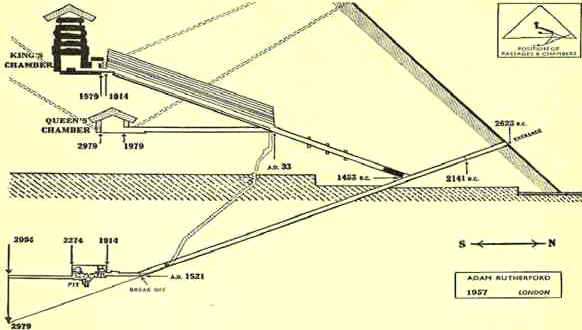PYRAMIDOLOGY
Pyramidology is a very interesting study that began in the 19th century. Robert Menzies, in 1865 thought that the various passages were constructed according to a chronological scale of a geometric inch to a year. For example if you start at a certain point in the descending passage and this is represented by a certain year, than every inch you move represents one year forward. Major landmarks in the pyramid seemed to correlate with major historical dates. For example, let us start in the descending passage at the location of some scored lines. We will assign this location a date of 2141 BC (we will explain later why this date was arbitrarily chosen) and move down the passage. For every inch we move we move forward in time one year (one inch equals one year theory). When we get to where the ascending passage intersects with us, we are at the year 1453 BC which is thought to be the date of the exodus. If we move up the ascending passage, we finally come to a place where it opens up into the grand gallery. At this juncture, the date is 33AD, the assumed date for the crucifixion of Jesus. Thus pyramiologists have correlated major locations in the pyramids passageways with important biblical and secular dates.
In order to have a chronology, you must have a starting point. Let us see how this was determined in the great pyramid. If we start from the outside of the north entrance and move down the descending passage about 40 feet, we come to series of so called "scored lines". These are straight knife-edge lines cut into the blocks from roof to floor. They are on each side of the passage and directly opposite each other. Also the descending passage is in exact alignment of true north. It can be shown that in the last 5,000 years, only at one time did the north star line up exactly with the descending passage and shine directly down. This occurred in 2141 BC and the north star at that time was Draconis also called the dragon star. The northern star changes gradually over long periods of time because of the precession of the earth on its axis (like a spinning top). Also only at that time, the star cluster known as the Pleiades in the constellation Taurus was in alignment with the scored lines. Thus this is the date that pyramidologists accept as the starting date at the scored lines. Measurements in inches from the scored lines represent chronology in years. Thus we count one year for every inch we move from the scored lines, starting at 2141 BC.
Now, if we move down the descending passage to the beginning of the ascending passage, we have moved a distance of 688 inches. If each inch represents one year we are at (2141 BC – 688 = 1453 BC). This year 1453 BC is accepted as the date of the exodus of the Israelites from Egypt. It symbolizes now the ascent of man towards god. If we move up the descending passage to a distance of 1485 inches, we come to the opening of the grand gallery. This year, 33 AD (1453 BC – 1485 = 33 AD) is considered to be the date of the crucifixion of Jesus Christ. If we move up the grand gallery to its end, we move 1881 inches. This year 1914 ad (33 AD – 1881 = 1914 AD), was the date of the beginning of the first world war. We can continue moving in the different passages and come up with different dates. Please refer to pyramid diagram above. Some of the pyramidologists attempted to predict future events, like the second coming of Jesus, the millennium, etc. But these events did not come to pass. It is possibly there is a chronology but the relationship is more complicated than the inch year theory.
Why did the pyramidoloigst chose the inch as the standard unit of measurement? The pyramidologists believe the linear unit used in the design of the great pyramid is the sacred cubic of 25.0265 British inches. The sacred cubit divided into 25 equal parts results in the sacred inch (also called pyramid inch) which equals 1.00106 British inches. Thus the pyramid inch is very close to our standard geometric inch. The derivation of this unit comes from measurements in the high central section of the King’s chamber passage, called the "antechamber". It has been found that the length of the antechamber is equal to the diameter of a circle having a circumference which measures as many pyramid inches as there are days in the solar year,365.242. Pyramidologists also point out that there are scientific values incorporated in the great pyramid, many not calculated or known since modern times.
For example, we mentioned that the unit of measurement in the pyramid is the pyramid inch. It turns out this is the basic unit of the measurement of the earth's polar radius. Remember there are 25 pyramid inches in a sacred cubit and there are exactly 10,000,000 sacred cubits from the center of the earth to its pole. Thus the earth's polar radius is 10,000,000 sacred cubits or 250,000,000 pyramid inches exactly.
Pyramidologists also have discovered many other scientific values in the pyramid. They include the mean density of the earth, the weight of the earth, mean temperature of the earth, the values of the solar, sidereal, and anomalistic years, and many others.
One of the most famous pyramidologists was Adam Rutherford who published a monumental 4 volume set on the subject. In our archives, we have a signed presentation copy from Dr. Rutherford to Dr. Louis Alvarez. Dr. Alvarez was awarded a Nobel Prize in physics, and developed the use of cosmic ray probes to find hidden chambers in the pyramids.
